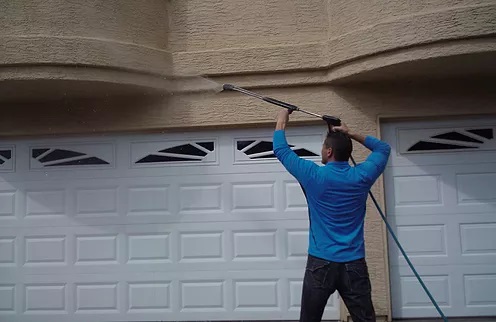
Power washing can be a fast and efficient way to clean exterior surfaces—but when paint is involved, things get tricky. Especially if the surface has older paint, possibly containing lead, you’ll want to proceed with caution.
So, is it safe to power wash painted surfaces? Yes—but only with the right tools, techniques, and precautions. Let’s explore how to do it safely and what to avoid when dealing with lead-based paint or fragile coatings. 🧼🧠
🖌️ Can You Pressure Wash Painted Surfaces?
In general, you can pressure wash painted surfaces, but whether you should depends on:
- The type of paint (acrylic, latex, oil-based)
- The surface underneath (wood, brick, metal, siding)
- The age and condition of the paint
- Whether the paint contains lead
💡 If the paint is flaking, chipping, or loosely bonded—power washing can do more harm than good.
🚨 What About Lead Paint?
This is where things get serious.
If your home was built before 1978, there’s a good chance it contains lead-based paint. Lead is a toxic heavy metal, and when pressure washed, it can:
- Create dangerous dust or paint chips
- Spread contaminated runoff into the soil, water, or air
- Pose serious health risks—especially to children and pets
- Lead to EPA fines if handled improperly during renovations
🛑 Never power wash a surface you suspect contains lead paint without testing it first.
🧪 How to Test for Lead Paint
Before any cleaning or renovation, test the paint using:
- DIY lead paint test kits (available at hardware stores)
- Certified inspectors who use XRF (x-ray fluorescence) machines
- Paint chip lab analysis for high-risk projects
If it’s lead-based, follow EPA Lead-Safe Certified procedures and don’t use high-pressure washing unless approved by a certified contractor.
✅ Safe Power Washing of Painted Surfaces (No Lead)
If you’ve confirmed the paint is lead-free, follow these steps for safe power washing:
1. Use the Right Pressure
- Stick to 1,200–2,000 PSI to avoid damaging paint
- Go lower for wood and older surfaces
- Use a 40° (white) or 25° (green) nozzle for a gentle spray
💡 Too much pressure can blast off good paint or cause it to peel later.
Browse Amazon Here For Top Rated Power Washers And Accessories
2. Maintain a Safe Distance
Keep your nozzle 12–24 inches away from the surface and avoid direct, close contact. Start from a distance and move closer only as needed.
👀 A test patch on an inconspicuous area can help prevent big mistakes.
3. Pre-Wet the Surface
Before applying detergent, rinse the area with plain water. This helps the surface absorb the cleaner evenly and reduces the risk of streaking or paint softening.
4. Use Paint-Safe Cleaners
Choose a detergent labeled safe for painted surfaces. Avoid bleach-heavy formulas, which can damage or discolor paint.
🧴 Apply the soap using a low-pressure nozzle or foam cannon and let it sit (but not dry) before rinsing.
5. Rinse Gently and Evenly
Use wide sweeps, rinse from the top down, and avoid staying in one spot too long. Let the surface air dry completely before making any decisions about touch-ups or repainting.
🚫 Avoid Power Washing If…
- The paint is peeling or flaking
- The surface is wood and unsealed
- The paint is chalky or heavily oxidized
- You suspect lead but haven’t tested for it
- The area is directly above flower beds, garden soil, or drainage that leads to natural water
⚠️ In these cases, consider soft washing or hand-scrubbing with a mild cleaner.
🛠️ Alternatives to Power Washing for Delicate Surfaces
If you’re concerned about stripping paint or damaging your home, consider:
- Soft washing: Uses low pressure and detergents instead of force
- Scrubbing with a long-handled brush
- Dry ice blasting (for sensitive restorations)
- Steam cleaning with proper safety controls
These options are safer for older or historic homes.
🌎 Environmentally-Safe Practices
- Capture runoff with tarps, gutters, or vacuum systems
- Avoid storm drains—paint-laced water can pollute waterways
- Dispose of rinse water properly (especially if using chemicals)
- Use biodegradable cleaners when possible
🌿 Clean responsibly—it’s good for your home and the planet.
✅ Final Thoughts
Power washing painted surfaces is possible and effective when done right. But when lead paint or aging finishes are involved, it’s crucial to act with caution and knowledge.
Test first. Use the right equipment. And always clean with purpose—not just pressure. 💪🎨🧼
Browse Amazon Here For Top Rated Power Washers And Accessories






